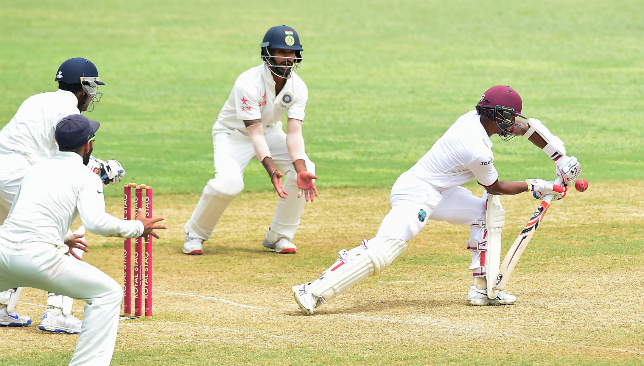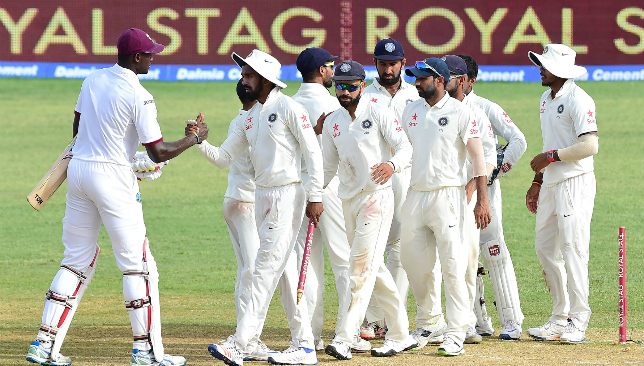
On day two of the second Test in Jamaica, Cheteshwar Pujara took 35 deliveries to get off his overnight score. The first hour of the morning session yielded 22 runs for India, and the direct impact of Pujara’s stonewalling could be felt. But after he got out post lunch, the scoring rate did pick up, albeit marginally, when Virat Kohli was at the crease.
Kohli and KL Rahul added 69 runs for the third wicket at 2.95/over, as compared to Rahul-Pujara scoring at 2.29. More importantly, it was slower than the Shikhar Dhawan-Kohli 105-run partnership at 3.86/over in the first Test.
When Ajinkya Rahane joined his skipper in the middle, the strike-rate moved to 4.21/over. Both like to play their shots obviously, but their scoring was still slower than their partnership rate of 4.56/over in Antigua.
Minimal change this, but over the course of a Test session they play out in terms of time. So, what had changed?
There were obvious differences in the pitches for the first and second Tests, and if anything, the Sabina Park pitch had more in it for the bowlers through the five days. Moreover, it was an improved effort from the West Indies’ bowlers that didn’t let the Indian batsmen get away with easy scoring.
Before he scored his maiden Test hundred and took his side to a fighting draw, Roston Chase picked his maiden five-wicket haul in the Indian innings. As with his battling knock, with the ball too he encapsulated what the hosts had planned to do in this second Test, and how well they executed it.
“The skipper told me to attack the stumps a bit more than I did last time, and that’s what I did. I found there was more spin and bounce in the pitch here than in the first Test, and I used it to good effect,” Chase had said after picking 5-121 on day three.

West Indies denied India a 2-0 lead
Jason Holder’s message to his pace bowlers was a touch different. “The plan was to hold things tight and not give away easy runs. We stressed on bowling to our plan even if wickets were not coming, but the pitch was the best to bat on days two and three. So the key was patience,” he explained, after the draw.
Two spells stand out herein. The first to Kohli, as his flowing boundaries were dried up. Frontline pacer Shannon Gabriel tested the Indian skipper outside his off-stump, even as the batsman refused to be drawn into playing drives.
Only this time, the pressure wasn’t let off from the other end as debutant Miguel Cummins too squared up Kohli. Twice the duo beat him, almost drawing a false shot, and he was lucky to be not given out LBW on 27* when Gabriel brought one into him.
Holder himself bowled the other definitive spell to Rahane. The batsman was beaten again and again, five times in the 142nd over of the Indian innings, managing to leave only one ball with ease. It frustrated him to no end as he looked to manufacture shots, and was almost dismissed as he cut Devendra Bishoo to point but was dropped.
Perhaps West Indies were let down in the field a touch. Let it be said here, though, at no point in their innings, Rahul and Rahane – the two centurions – or any other Indian batsman for that matter were in cruise mode.
In a rain-affected game, this proved to be the difference. Losing four-plus sessions to tropical storm Earl evened things up, particularly as constant rain and sunshine on alternate days took the sting out of the day five Sabina Park pitch.
Chase’s knock of 137* was one of perseverance and determination, as he built a strong lower-order rear guard with help from his teammates. At the same time, it is also true that the wicket had drastically eased off, in complete contrast to the hosts’ first innings on day one, or indeed during the hour they batted on day four.
This difference in conditions was a real test for the five-pronged Indian attack. Over the last couple seasons, especially with the Test captaincy moving on from MS Dhoni to Kohli, five bowlers has become a norm in the longer format.
With a relatively more aggressive skipper, the tactic of deploying bowlers in short bursts, and a better fielding unit developed over the years supporting them, taking 6 wickets in 98.1 overs over three sessions seemed doable.
Instead, this second Test has now joined a list of instances when India failed to break through, and earned a draw from their position of dominance. The failure of the pacers to attack the stumps, and Kohli’s dubious decision to not deploy R Ashwin as soon as possible, hampered their chances.
Kingston (2016) became a throwback to the likes of Johannesburg (2013) and Wellington (2014). India’s big differentiator from those times, playing the fifth bowler, didn’t work.“When you lose a Test and behind in the second, it takes something special to save the match,” said a magnanimous Kohli afterwards.
Rest assured though, despite their stunning fight back, West Indies haven’t closed the gap in quality between the two teams. But from the first to the second Test, they were the team to bring a lift in their performance, both with bat and ball, and that should be worrying the Indian captain.
His team is still the better side, going into the third Test at St. Lucia. Yet, they should have been leading by 2-0 at this juncture, never mind the rain. That’s what teams, who aspire to be the no.1 Test side soon enough, do. That their five bowlers couldn’t finish the job ought to spell it out for Kohli and his think tank that this isn’t going to be an easy-does-it ride.
Consequently then, will this factor bring about a change in strategy for the visitors? Will Ravindra Jadeja come into the scheme of things, when the series resumes on a batsmen-friendly wicket at the Darren Sammy Stadium on Tuesday?